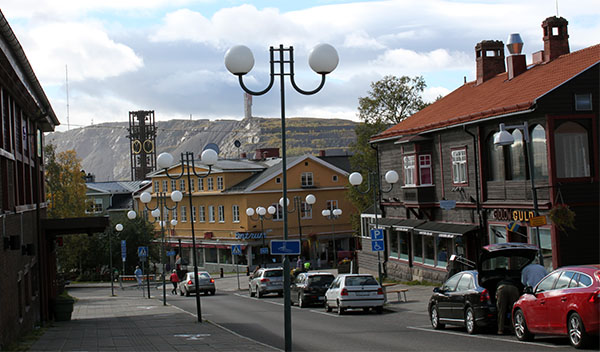Moving a city
Göran Cars, Professor in Urban Planning, has been working with the Kiruna city transformation since the turn of the year. The mine beneath the city is causing the formation of fissures, which is why parts of the city are being moved 3 km to the east. In 2016, a new city hall will be the first structure to be completed.

The Kiirunavaara mine is the world's largest and most modern underground mine.
The four-kilometre long ore body leans toward the city, and when the waste rock on one side fills cavities arising from the ore-mining, deformations are created which necessitate the city being relocated.

Göran Cars has been engaged as project manager in a half-time position by Kiruna Municipality and works together with a development group with representatives from the municipality, LKAB, the Swedish Transport Administration and the County Administrative Board. The relocation is scheduled to take place in three stages. In total, 3,000 new homes will be built. Kiruna will get a new city centre as well as municipal services such as child care, schools and libraries.
"The current city centre is sparse and spread out. Kiruna was built as a model city around the turn of the last century. The city plan was unique insofar as it took into account geography and climate, something which was not done when the road network was redesigned in the 60s and 70s. It is a unique opportunity to build a new city. The new city centre will be more densely laid out, including a main street where residential housing, stores and cultural facilities will coexist. A main square is also on the residents' wish list," says Göran.
There is a housing shortage in Kiruna, and the increase in the demand for iron ore means that 2,000 new residential properties need to be built. There is also a lack of hotel locations, and there is an active interest in building hotels due to the explosion in tourism in recent years. In the winter there is great international interest in the northern lights and the wilderness of the region.
Since the ground displacement has been caused by the mining operations, it is LKAB who will pay for the city transformation.
"With national interests such as reindeer herding, minerals and outdoor pursuits, it has not been easy to find land for the new city. The County Administrative Board has had to prioritise, and a reason for not moving the city further away is the desire to, as far as possible, keep Kiruna together during the transformation. When it comes to the stores, the move is tricky. Who wants to be the first to move to the new location? There has to be an economic enticement making it attractive for others to follow suit."
The Kiruna city transformation is a complex process and several experts in real estate economics, land law and urban planning from the School of Architecture and the Built Environment have participated in the project. There is a great need for knowledge among politicians, city officials and the public regarding issues such as how to value different types of properties. Home owners and store owners have concerns for the future. Will the buying or renting of new residential properties and business premises by affordable in the new location?
Despite these worries, there is an overall high level of acceptance among the Kiruna residents when it comes to the relocation of their city.

"One ambition is to try to manifest the pride that exists in the city by relocating and preserving some special buildings and building new ones that represent the same spirit. Kiruna Church, one of the country's largest wood structures, will be dismantled piece by piece and rebuilt at the new location. It is not possible to relocate the City Hall, which is beloved and often visited by Kiruna residents. This would have required the building of wider roads. A new city hall will be built, and the current bell tower will be part of the structure.
"I will work with the city transformation for three years to begin with. It is incredibly fun and interesting to combine the academic work with reality. The work has entered a very intensive phase right now. In October 2013, the development plan for Phase 1 of New Kiruna is being presented. The construction begins in 2014 and will comprise a new city hall, a city hotel, stores, pedestrian streets and residential housing grouped around the city's new main square," concludes Göran Cars.
Text and photos: Maria Hult

